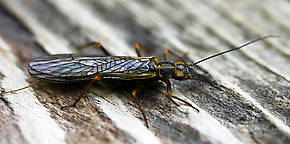Blog & Latest Updates
Fly Fishing Articles
Insects by Common Name


Animal Kingdom Animalia (Animals)
Taxonomic Navigation -?-
Kingdom Animalia (Animals)
| Phylum in Animalia | ||
| AnnelidaWorms and Leeches | 0 | 2 |
| ArthropodaArthropods | 0 | 122 |
| ChordataVertebrates | 0 | 4 |
| Mollusca | 0 | 6 |
| PlatyhelminthesFlatworms | 0 | 0 |
Common Name
| Match | Common Name |
| Animals |
This is page 75 of specimens of Animalia. Visit the main Animalia page for:
- The behavior and habitat of Animalia.
- 131 underwater pictures of Animalia.
Pictures of 1264 Animal Specimens:
Male Ameletus vernalis (Brown Dun) Mayfly Dun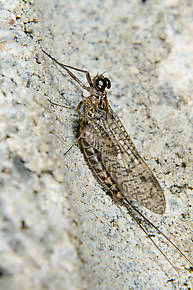 View 1 Pictures
View 1 Pictures
 View 1 Pictures
View 1 PicturesCollected April 29, 2012 from the Touchet River in Washington
Added to Troutnut.com by Bnewell on April 30, 2012
Added to Troutnut.com by Bnewell on April 30, 2012
Male Rhithrogena morrisoni (Western March Brown) Mayfly Adult View 1 Pictures
View 1 Pictures
 View 1 Pictures
View 1 PicturesCollected May 2, 2011 from the Touchet River in Washington
Added to Troutnut.com by Bnewell on June 27, 2011
Added to Troutnut.com by Bnewell on June 27, 2011
Female Ameletus oregonensis (Brown Dun) Mayfly Spinner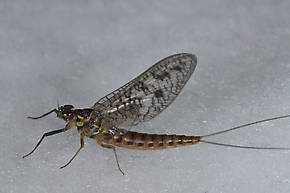 View 1 Pictures
View 1 Pictures
 View 1 Pictures
View 1 PicturesCollected June 20, 2012 from the Touchet River in Washington
Added to Troutnut.com by Bnewell on June 21, 2012
Added to Troutnut.com by Bnewell on June 21, 2012
Claassenia sabulosa (Golden Stone) Stonefly Nymph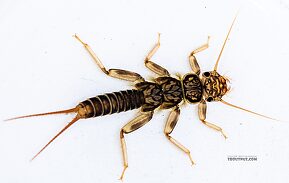 View 11 PicturesThis striking golden stonefly is the first of its species I've had the chance to photograph.
View 11 PicturesThis striking golden stonefly is the first of its species I've had the chance to photograph.
 View 11 PicturesThis striking golden stonefly is the first of its species I've had the chance to photograph.
View 11 PicturesThis striking golden stonefly is the first of its species I've had the chance to photograph.Collected April 12, 2021 from Holder Creek in Washington
Added to Troutnut.com by Troutnut on April 13, 2021
Added to Troutnut.com by Troutnut on April 13, 2021
Neoephemera Mayfly Nymph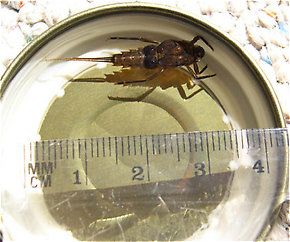 View 7 PicturesThis specimen was sent to me for identification by Caleb Boyle, who did such a good job taking pictures of his mystery mayfly that, after identification, I asked him for permission to add it to this site, which he granted. This is great luck, since Neoephemera is a rare mayfly and it's unlikely I would ever have collected a specimen for the site myself.
View 7 PicturesThis specimen was sent to me for identification by Caleb Boyle, who did such a good job taking pictures of his mystery mayfly that, after identification, I asked him for permission to add it to this site, which he granted. This is great luck, since Neoephemera is a rare mayfly and it's unlikely I would ever have collected a specimen for the site myself.
Caleb collected it in mid-late May of 2004 either McDowell County or Ashe County in North Carolina, in a riffle less than two feet deep in a cold trout stream. He reared the nymph into a dun, whose wings appear in one of the photos below. He describes the specimen as follows:
I don't know to which species it belongs, but its size rules out the most common one in the genus, Neoephemera bicolor. It matches the size of Neoephemera purporea so that is a likely other possibility, but there are two other candidate species (Neoephemera compressa and Neoephemera youngi) about which I have no information, so I can't rule them out.
Disregard the camera, region, and exact date listed on these photos. I still need to update the site to accommodate user contributions which don't use my equipment.
 View 7 PicturesThis specimen was sent to me for identification by Caleb Boyle, who did such a good job taking pictures of his mystery mayfly that, after identification, I asked him for permission to add it to this site, which he granted. This is great luck, since Neoephemera is a rare mayfly and it's unlikely I would ever have collected a specimen for the site myself.
View 7 PicturesThis specimen was sent to me for identification by Caleb Boyle, who did such a good job taking pictures of his mystery mayfly that, after identification, I asked him for permission to add it to this site, which he granted. This is great luck, since Neoephemera is a rare mayfly and it's unlikely I would ever have collected a specimen for the site myself. Caleb collected it in mid-late May of 2004 either McDowell County or Ashe County in North Carolina, in a riffle less than two feet deep in a cold trout stream. He reared the nymph into a dun, whose wings appear in one of the photos below. He describes the specimen as follows:
Nymph exoskeleton:
Body: 16-17mm
Tails: 3, equal length, 13mm
Found on the surface of the water. The gill cover covers ab. segments 3-5.
Subimago (Subimago: Mayfly nymphs emerge from the water into subimagoes, better known to anglers as "duns." They are a sexually immature, winged, recognizably adult stage and they must molt one more time into imagoes or "spinners" before they can mate.):
Body: 16mm, dark brown/ olive
Tails: 3, equal length, 14mm
Wings: dark slate color, large hind wings.
I don't know to which species it belongs, but its size rules out the most common one in the genus, Neoephemera bicolor. It matches the size of Neoephemera purporea so that is a likely other possibility, but there are two other candidate species (Neoephemera compressa and Neoephemera youngi) about which I have no information, so I can't rule them out.
Disregard the camera, region, and exact date listed on these photos. I still need to update the site to accommodate user contributions which don't use my equipment.
Collected May 20, 2004 from unknown in North Carolina
Added to Troutnut.com by Troutnut on March 20, 2007
Added to Troutnut.com by Troutnut on March 20, 2007
Cinygmula reticulata (Western Ginger Quill) Mayfly Nymph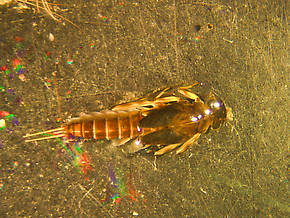 View 1 PicturesI collected several live specimens of nymphs and reared them to the imago (Imago: The sexually mature adult stage of the mayfly is called the imago by scientists and the spinner by anglers.) stage. They were C. reticulata. The interesting thing is they were collected in May and were emerging along with Rhithrogena (March Brown). This seems to be an overlooked hatch since in some rivers it emerges very early, before runoff.
View 1 PicturesI collected several live specimens of nymphs and reared them to the imago (Imago: The sexually mature adult stage of the mayfly is called the imago by scientists and the spinner by anglers.) stage. They were C. reticulata. The interesting thing is they were collected in May and were emerging along with Rhithrogena (March Brown). This seems to be an overlooked hatch since in some rivers it emerges very early, before runoff.
 View 1 PicturesI collected several live specimens of nymphs and reared them to the imago (Imago: The sexually mature adult stage of the mayfly is called the imago by scientists and the spinner by anglers.) stage. They were C. reticulata. The interesting thing is they were collected in May and were emerging along with Rhithrogena (March Brown). This seems to be an overlooked hatch since in some rivers it emerges very early, before runoff.
View 1 PicturesI collected several live specimens of nymphs and reared them to the imago (Imago: The sexually mature adult stage of the mayfly is called the imago by scientists and the spinner by anglers.) stage. They were C. reticulata. The interesting thing is they were collected in May and were emerging along with Rhithrogena (March Brown). This seems to be an overlooked hatch since in some rivers it emerges very early, before runoff.Collected May 10, 2009 from the Big Thompson River in Montana
Added to Troutnut.com by Bnewell on June 26, 2011
Added to Troutnut.com by Bnewell on June 26, 2011
Lepidostoma podagrum (Little Brown Sedge) Little Brown Sedge Larva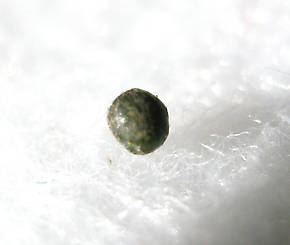 View 1 PicturesThis egg packet was dropped from the specimen with the severely foreshortened abdomen in the other photo series. It's amazing how much abdominal length is given up in this process. The egg packet looked black in the hand.
View 1 PicturesThis egg packet was dropped from the specimen with the severely foreshortened abdomen in the other photo series. It's amazing how much abdominal length is given up in this process. The egg packet looked black in the hand.
 View 1 PicturesThis egg packet was dropped from the specimen with the severely foreshortened abdomen in the other photo series. It's amazing how much abdominal length is given up in this process. The egg packet looked black in the hand.
View 1 PicturesThis egg packet was dropped from the specimen with the severely foreshortened abdomen in the other photo series. It's amazing how much abdominal length is given up in this process. The egg packet looked black in the hand.Collected May 12, 2011 from the Fall River in California
Added to Troutnut.com by Entoman on December 14, 2011
Added to Troutnut.com by Entoman on December 14, 2011
Ephemerella excrucians (Pale Morning Dun) Mayfly Nymph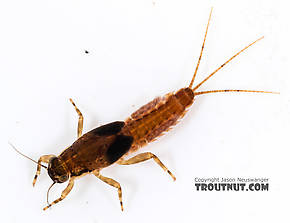 View 5 Pictures
View 5 Pictures
 View 5 Pictures
View 5 PicturesCollected June 16, 2018 from the South Fork Snoqualmie River in Washington
Added to Troutnut.com by Troutnut on June 18, 2018
Added to Troutnut.com by Troutnut on June 18, 2018
Rhithrogena Mayfly Nymph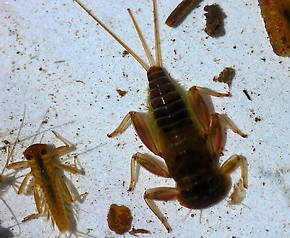 View 1 PicturesBased on the lack of coloration and the two bars on the last tergite (
View 1 PicturesBased on the lack of coloration and the two bars on the last tergite (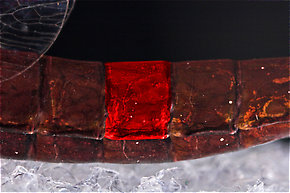 Tergite: The top (dorsal) part of a single segment on an insect's abdomen when it consists of a single chitinous plate (sclerite), or an individual sclerite if the segment has more than one.) this may be Rhithrogena virilis.
Tergite: The top (dorsal) part of a single segment on an insect's abdomen when it consists of a single chitinous plate (sclerite), or an individual sclerite if the segment has more than one.) this may be Rhithrogena virilis.
 View 1 PicturesBased on the lack of coloration and the two bars on the last tergite (
View 1 PicturesBased on the lack of coloration and the two bars on the last tergite (
One tergite of this Isonychia bicolor mayfly spinner is highlighted in red.
Collected May 12, 2005 from Hungry Horse Creek in Montana
Added to Troutnut.com by Bnewell on June 28, 2011
Added to Troutnut.com by Bnewell on June 28, 2011
Top 10 Fly Hatches
Top Gift Shop Designs
Eat mayflies.
Top Insect Specimens
Miscellaneous Sites
Troutnut.com is copyright © 2004-2024 Jason
Neuswanger (email Jason). See my FAQ for information about use of my images.
 privacy policy
privacy policy

